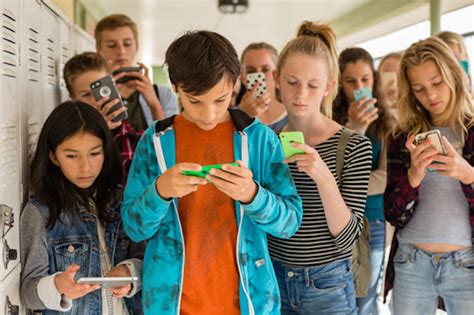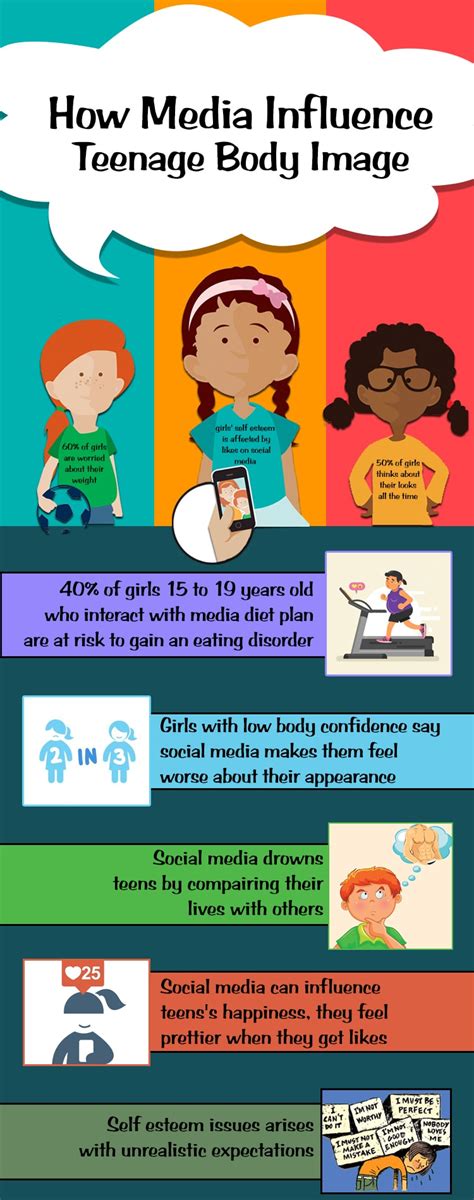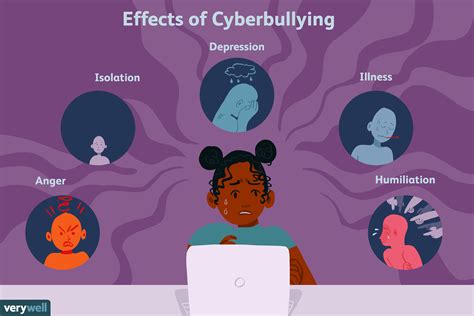In today's technologically advanced era, the ubiquity of virtual communication channels has significantly altered the manner in which young individuals engage with the world around them. The rapid proliferation of online platforms has sparked a revolution in the ways adolescents communicate, exchange information, and seek entertainment. This unprecedented transformation in social interaction has opened up a multitude of pathways for self-expression, connectivity, and knowledge-sharing among teenagers. However, the omnipresence of digital media has also brought about a plethora of psychological challenges, particularly when it comes to the mental well-being of the younger generation.
The emergence of virtual platforms has revolutionized the concept of interpersonal relationships and engendered an extensive array of opportunities for personal growth. These platforms provide a space for adolescents to forge new connections, explore diverse perspectives, and develop a sense of identity in an interconnected global society. By allowing individuals to exhibit their creativity, thoughts, and emotions, these digital spaces have fostered a sense of empowerment and belongingness among teenagers.
Nevertheless, alongside these positive aspects, there exists a pressing concern surrounding the emotional health and well-being of adolescents within the digital realm. The exponential growth of social media has coincided with an increase in mental health issues among teenagers. Research suggests a correlation between excessive usage of digital platforms and the prevalence of anxiety, depression, and other psychological disorders. This alarming trend has raised questions about the potential detrimental effects of virtual communication on adolescent mental health.
While social media boasts numerous advantages, its impact on the emotional well-being of teenagers cannot be ignored. The constant exposure to carefully curated digital content, the pressure to attain unrealistic standards, and the fear of social exclusion have all contributed to an alarming rise in psychological distress among adolescents. The 24/7 nature of online platforms blurs the boundaries between personal and virtual lives, leading to a heightened vulnerability and a diminished capacity for self-reflection. Thus, it is imperative to explore the intricate relationship between digital media and mental health in order to develop effective strategies that mitigate the adverse effects and promote a digitally resilient adolescent population.
The Emergence of Social Media Influence on Adolescents

With the rapid advancements in technology, a new era has dawned upon the younger generation, revolutionizing their social interactions and behavior. This section delves into the growing prominence and impact of online platforms on the mental well-being of adolescents, exploring the various facets of social media influence on this vulnerable age group.
Examining the Relationship between Social Networking and Adolescent Desolation
Youth, in the formative stages of their lives, are increasingly immersing themselves in the digital realm, connecting with others via various online platforms. This section delves into the intricate association between the utilization of internet-based social networks and the emotional well-being of adolescents. It aims to shed light on the potential ties between excessive engagement with social media and the prevalence of teenage despondency.
Social Media and its Effects on Adolescents' Body Image

In today's digital era, the power of online platforms has significantly influenced young individuals' perception of their physical appearance. The surge in popularity of social media platforms has introduced new challenges in the form of body image issues among teenagers.
When adolescents browse through their social media feeds, they are bombarded with carefully curated images that present an unrealistic standard of beauty. These images often depict individuals with flawless skin, perfectly toned bodies, and ideal proportions. This constant exposure to idealized body types can lead to feelings of inadequacy and discontent with one's own appearance.
Moreover, social media platforms accentuate the importance of physical attractiveness by prioritizing likes, comments, and followers. The number of likes and comments a post receives can serve as a measure of validation and acceptance for teenagers. This pressure to conform to societal beauty standards can have detrimental effects on their self-esteem and body image.
In addition to curated images, social media platforms are also home to countless forums and groups dedicated to discussions and comparisons of physical appearance. These platforms can foster a toxic environment where individuals engage in body shaming, bullying, and negative self-talk. Participating in such online communities can further erode teenagers' self-esteem and perpetuate body dissatisfaction.
Furthermore, the constant exposure to edited and filtered images on social media can distort teenagers' perception of reality. They may develop unrealistic expectations about how their bodies should look and strive for unattainable standards. This can lead to a variety of harmful behaviors, including excessive exercise, strict diets, and even the development of eating disorders.
To combat the negative effects of social media on adolescents' body image, it is crucial to promote media literacy and critical thinking skills. Educating teenagers about the manipulative nature of digital platforms and encouraging them to engage in positive self-talk can help counteract the negative impact. Additionally, fostering real-life connections, promoting offline activities, and cultivating a supportive environment can help teenagers develop a healthier body image.
- Limiting screen time and encouraging a healthy balance between online and offline activities
- Encouraging open discussions about body image and self-acceptance
- Teaching media literacy skills to help teenagers recognize and challenge unrealistic portrayals of beauty
- Promoting positive self-talk and body positivity
- Providing access to mental health resources and support for those struggling with body image issues
By addressing the harmful effects of social media on adolescents' body image, we can empower young individuals to develop a positive and healthy relationship with their own bodies, free from the pressures of unrealistic standards perpetuated by online platforms.
Loneliness and Social Media: A Perilous Combination for Adolescents
In today's digital age, where connectivity and virtual interactions redefine the way we communicate, the association between loneliness and social media emerges as an alarming concern for the well-being of teenagers. The omnipresence of social media platforms, along with their captivating allure, can potentially intensify feelings of isolation and exacerbate mental health issues among adolescents.
The Loneliness Epidemic Loneliness, synonymous with solitude, seclusion, or emptiness, becomes a profound emotional burden for many adolescents. It is a complex and subjective experience that arises from a disconnect in social connections, leading to feelings of social isolation and dissatisfaction with the quality and quantity of relationships. The pervasive nature of loneliness is further magnified by the explosion of social media in contemporary society. |
Social Media's Illusion of Connection Social media platforms seem to offer an endless stream of virtual connections, friend requests, and followers, giving the illusion of companionship and inclusion. However, this digital façade often fails to address the fundamental human need for authentic and meaningful interactions. The easy access to curated and edited versions of others' lives can evoke envy, inadequacy, and further distance individuals from genuine social connections, perpetuating the cycle of loneliness. |
The Vicious Cycle Social media's role in exacerbating loneliness among teenagers is not only limited to its impact on forming new relationships but also on the preservation of existing ones. Constant exposure to a highlight reel of peers' seemingly perfect lives can intensify feelings of loneliness and inadequacy, contributing to the development of mental health issues such as anxiety and depression. This, in turn, may lead to further social withdrawal, perpetuating a vicious cycle that can be detrimental to an adolescent's overall well-being. |
Breaking the Cycle It is crucial to recognize the potential dangers of the combination of loneliness and social media for teenagers and take steps towards effective interventions. Encouraging face-to-face interactions, reducing screen time, and fostering a supportive and inclusive offline environment are essential strategies to counterbalance the negative effects of social media and promote healthy social connections. By addressing the issue at its roots, we can mitigate the adverse consequences of this perilous combination and protect the mental health of adolescents. |
The Role of Cyberbullying in Adolescent Emotional Well-being

Cyberbullying, commonly known as online harassment, has emerged as a significant concern in relation to the psychological well-being of young individuals. The ubiquitous nature of internet access and the popularity of social networking platforms have inadvertently provided a breeding ground for harmful behavior, which can have detrimental effects on the mental health of adolescents.
1. Cyberbullying: A Dehumanizing Experience
- Introduce the concept of cyberbullying and its different forms such as harassment, flaming, and exclusionary practices.
- Highlight the dehumanizing nature of cyberbullying, where victims are targeted and attacked online, often anonymously.
- Discuss the persistent nature of cyberbullying, as harmful content can be easily shared and remain accessible long after it has been posted.
2. Psychological Impact of Cyberbullying
- Explore the emotional consequences of cyberbullying, such as increased levels of anxiety, depression, and feelings of loneliness.
- Explain how cyberbullying can lead to low self-esteem, decreased self-worth, and a negative body image.
- Discuss the correlation between cyberbullying and a higher risk of suicidal ideation and self-harm among teenagers.
3. Exacerbating Factors: Social Media and Online Platforms
- Examine how the accessibility and popularity of social media platforms contribute to the prevalence of cyberbullying.
- Discuss how the anonymity provided by these platforms can embolden perpetrators, leading to increased incidents of cyberbullying.
- Highlight the viral nature of harmful content on social media and its potential to reach a wide audience, amplifying the negative impact on victims' mental health.
4. Preventative Measures and Support for Victims
- Suggest proactive strategies to prevent cyberbullying, including education programs, awareness campaigns, and promoting responsible online behavior.
- Discuss the importance of fostering a supportive environment where victims feel comfortable reaching out for help and reporting incidents.
- Explore the role of parents, educators, and mental health professionals in identifying and addressing cyberbullying, providing necessary support, and promoting resilience.
The pervasive nature of cyberbullying in adolescents' lives necessitates a comprehensive understanding of its contribution to mental health issues. By recognizing the role and impact of cyberbullying, society can work towards creating safer online spaces for young individuals to thrive and cultivate positive mental well-being.
Social Media Addiction and its Impact on Adolescent Well-being
Today's interconnected digital landscape presents a burgeoning concern: the widespread rise of social media addiction among young people. Recognizing the detrimental effects this addiction can have on adolescents' mental well-being is crucial in order to address this issue effectively.
With social media platforms becoming an integral part of daily life, teenagers are increasingly prone to excessive usage, resulting in addiction-like behaviors. As they obsessively check notifications, scroll endlessly through their feeds, and seek validation through likes and comments, the boundaries between the virtual world and reality begin to blur, putting their mental well-being at risk.
The all-consuming nature of social media addiction can lead to a range of negative consequences on teenagers' mental health. Constant comparison to others' filtered and curated lives fosters feelings of inadequacy, low self-esteem, and diminished self-worth. The prevalent culture of displaying only the highlights of one's life perpetuates a distorted sense of reality, amplifying feelings of loneliness, anxiety, and depression.
Moreover, social media addiction disrupts crucial aspects of adolescent development. As teenagers spend excessive amounts of time online, they may neglect face-to-face interactions, hindering their ability to cultivate healthy relationships and develop vital social skills. The constant exposure to cyberbullying, cyberstalking, and online harassment further exacerbates these issues, fueling emotional distress and social isolation.
It is imperative that we educate teenagers about the potential dangers of social media addiction and provide them with the tools to foster a balanced relationship with digital platforms. By promoting digital literacy and prioritizing offline activities, we can empower adolescents to navigate the digital world responsibly, protect their mental well-being, and foster healthy connections in both their virtual and real lives.
Strategies for Parents and Teachers to Support Adolescents in Safely Navigating the Digital Environment

Adolescents today face unique challenges in the digital landscape, including social media platforms that can both empower and potentially harm their well-being. In order to ensure their safety and foster a positive online experience, parents and teachers play a crucial role in guiding adolescents through the intricacies of social media.
1. Promote Open CommunicationEncourage adolescents to openly discuss their online experiences, concerns, and apprehensions with parents and teachers, fostering an environment where they feel safe sharing their thoughts. By engaging in meaningful conversations, adults can better understand the challenges faced by adolescents and offer appropriate guidance. |
2. Set Clear BoundariesEstablish clear guidelines and expectations regarding the use of social media. Encourage adolescents to set limits on screen time, create healthy online habits, and prioritize offline activities, such as hobbies and face-to-face interactions. By instilling boundaries, parents and teachers can help adolescents strike a balance between their virtual and real-life experiences. |
3. Teach Critical ThinkingEquip adolescents with the skills to critically analyze the content they encounter on social media. Teach them to question the credibility of information, identify manipulative tactics, and recognize the potential consequences of online actions. By fostering critical thinking abilities, parents and teachers empower adolescents to make informed decisions and navigate social media safely. |
4. Encourage Positive Online BehaviorPromote positive online behavior by stressing the importance of empathy, respect, and kindness in digital interactions. Encourage adolescents to think before posting or commenting, reminding them of the potential impact their words may have on others. By fostering a culture of positivity and inclusivity, parents and teachers can help mitigate the negative effects of social media. |
5. Be a Digital Role ModelLead by example by demonstrating responsible digital behavior. Parents and teachers should strive to maintain a healthy relationship with technology, practicing mindfulness and setting clear expectations for themselves. By acting as positive role models, adults can inspire adolescents to emulate healthy digital habits. |
FAQ
Does excessive use of social media lead to mental health problems in teenagers?
Yes, excessive use of social media has been linked to mental health problems in teenagers. Studies have shown that spending too much time on social media platforms can contribute to feelings of depression, anxiety, and low self-esteem.
How does social media affect the self-esteem of teenagers?
Social media can significantly impact the self-esteem of teenagers. When teenagers constantly compare themselves to others on social media, it can lead to feelings of inadequacy and lower self-esteem. The constant exposure to curated and idealized versions of other people's lives can make teenagers feel like they don't measure up.
Are there any positive effects of social media on teenagers' mental health?
While excessive use of social media can have negative effects, it's important to note that there can be positive effects as well. Social media can provide a platform for teenagers to express themselves, find support from peers going through similar experiences, and access helpful mental health resources.
What steps can teenagers take to protect their mental health on social media?
Teenagers can take several steps to protect their mental health on social media. They should set limits on their social media usage, actively curate their social media feeds to follow accounts that promote positivity and mental well-being, and engage in offline activities that promote a healthy balance between virtual and real-life interactions.
How can parents help their teenagers navigate the impact of social media on their mental health?
Parents can play a crucial role in supporting their teenagers in navigating the impact of social media on their mental health. They should have open and honest conversations with their teenagers about the potential negative effects of excessive social media use and help them develop healthy media habits. Parents can also encourage offline activities, provide emotional support, and help their teenagers seek professional help if needed.
What is the impact of social media on teenagers' mental health?
The impact of social media on teenagers' mental health can be significant. Research has shown that excessive use of social media can contribute to feelings of depression, anxiety, and low self-esteem. It can also lead to cyberbullying and feelings of social isolation.
How does social media affect teenagers' self-esteem?
Social media can have a negative impact on teenagers' self-esteem. Constant exposure to carefully curated and filtered images on social media platforms can make teenagers feel inadequate and create a distorted view of reality. Comparing themselves to others can lead to feelings of low self-worth and dissatisfaction with their own lives.



